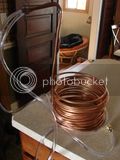So as a mechanical engineer, this kind of stuff is really interesting to me.
So a wort chiller is basically a heat exchanger. With any heat eachanger, the efficinency (a technical term, but basically a synonym for effectiveness) is related to the length of the pipe, the material the pipe is made out of, the fluid flowing through on either side and the temperature difference. In the case of a wort chiller, copper's a great choice, you're not going to rig up some special cooling fluid, and the temperature of your faucet is mostly out of your control (unless you rig up an ice water prechiller). The only thing you can really change is the length.
The way the physics works is the heat energy exchanged is related to the temperature difference between the fluid in and the fluid outside the heat exchanger (a logarithmic relation to be overly spesific). So for example, the fluid in the copper will pick up the most energy right when it enters the hot wort, and when the wort is almost at the temperature of the water from your faucet, the heat exchanger will be picking up almost no additional energy. This being said, at the very end of the length of pipe, the water inside the copper is closest to the temperature of the wort and adding more length is less effective. You would see a drop in cooling time betweein 25 and 50 feet and even a drop still if you use 100 feet, but the drop will be small compared to the price of copper required to achieve it. A simple (well for those with a degree in engineering

) efficiency calculation will reveal the usefullness of adding one more unit of length to your heat exchanger, but a much more effective use of your pipe would be to construct a second heat exchanger and run it in the oppisite direction.
If you were to use all 50 feet of the pipe and made two heat exhangers with one nesting inside (leave enough room for your wort to flow freely) and ran them in oppisite directions, you could create a rudimentary counter flow heat exhanger. In a counter flow heat exchanger, the hottest liquid inside the heat exchanger comes in contact with the hottest fluid outside. With this being the case, it is possible to extract more energy out of your hot fluid and in our case, cool your wort faster. You also increase the flow rate of cool fluid through your wort, further decreasing the time to cool.
This setup would require two sources of water and that could be unfeasible, but it would be a better way to use your copper. It would also make you look fancy and you can use some engineering jargon to impress your happy chilled and soon to be alcoholic beer/friends








![Craft A Brew - Safale S-04 Dry Yeast - Fermentis - English Ale Dry Yeast - For English and American Ales and Hard Apple Ciders - Ingredients for Home Brewing - Beer Making Supplies - [1 Pack]](https://m.media-amazon.com/images/I/41fVGNh6JfL._SL500_.jpg)



















































